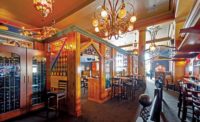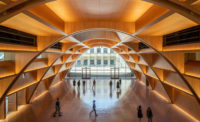Renovation Best Project - CBRE Masonic Temple

Photo by Gensler/Ryan Gobuty

Photo by Benny Chan/Fotoworks

Photo by Gensler/Ryan Gobuty



CBRE Masonic Temple
Glendale
BEST PROJECT, RENOVATION/RESTORATION
Owner Caruso Affiliated
Lead Designer Gensler
Contractor W.E. O’Neil Construction
Civil Engineer Peak Surveys Inc.
Structural Engineer Structural Focus
MEP Engineer Davidovich & Associates
Commercial Real Estate Services CBRE
Lighting Designer Kaplan Gehring McCarroll Architectural Lighting
Empty for 30 years, the eight-story Masonic Temple in Glendale, Calif., is now a spacious, productive office workplace that balances contemporary needs, current building standards and styles with the original 20th-century Art Deco features. The second-tallest building in Glendale when built in 1928, the landmark property was listed in the city’s Historic Registry in 1997.
The local historical preservation agency originally recommended restoring the entire property. However, after the client lobbied to limit the scope of restoration to the building’s exterior, designers took an adaptive reuse approach to make the interior space more productive and profitable.
After a complete seismic analysis, the adaptive-reuse renovation required demolishing floors and stairwells and excavating new foundations. Existing concrete-encased steel and board-formed concrete walls were upgraded for fenestration on the north, south and east facades. To structurally retrofit interior walls, crews used a fiber-wrap material instead of invasive structural-steel framing.
A new eighth-floor mezzanine level was suspended from the historic wood-clad steel roof trusses to become a “space within a space.” Crews also installed a two-car elevator bank and added two egress stairs. In addition, the team recreated the quality and detail of the original craftsmanship, including millwork in the main lobby and the reproduction metal ornamental grille work on the entry façade.
Because the original building function included secretive Masonic rites, its upper floors had small windows. The new larger windows bring more light into the work areas.
The extensive and complex interior work created a jobsite with significant risks, making the zero-incident safety record all the more impressive, according to Best Projects judges. The project team’s safety diligence ensured that signage, delineations, anchorage points, fall protection equipment, guardrails and safety audits were installed and correctly employed.







